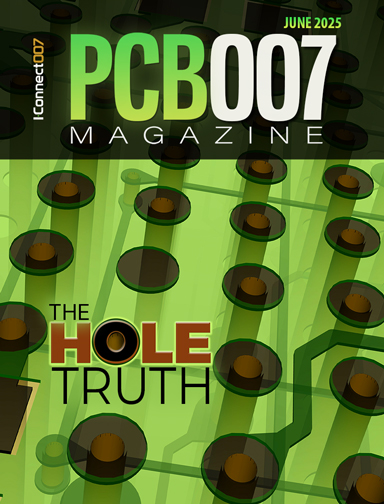-

- News
- Books
Featured Books
- pcb007 Magazine
Latest Issues
Current Issue
The Hole Truth: Via Integrity in an HDI World
From the drilled hole to registration across multiple sequential lamination cycles, to the quality of your copper plating, via reliability in an HDI world is becoming an ever-greater challenge. This month we look at “The Hole Truth,” from creating the “perfect” via to how you can assure via quality and reliability, the first time, every time.

In Pursuit of Perfection: Defect Reduction
For bare PCB board fabrication, defect reduction is a critical aspect of a company's bottom line profitability. In this issue, we examine how imaging, etching, and plating processes can provide information and insight into reducing defects and increasing yields.

Voices of the Industry
We take the pulse of the PCB industry by sharing insights from leading fabricators and suppliers in this month's issue. We've gathered their thoughts on the new U.S. administration, spending, the war in Ukraine, and their most pressing needs. It’s an eye-opening and enlightening look behind the curtain.
- Articles
- Columns
Search Console
- Links
- Media kit
||| MENU - pcb007 Magazine
If You Can Define It Right, You Can Design It Right
December 5, 2024 | Andy Shaughnessy, Design007Estimated reading time: 1 minute
Design engineer Chris Young is known for his optimized design process. As lead hardware engineer with Moog Space and Defense Group and owner of Young Engineering Services, Chris collects data like it’s going out of style, and he leaves nothing to chance.
With that in mind, I asked Chris to discuss his views on rules of thumb—which ones work, which ones should be avoided, and how rules fit ideally into the PCB design process.
Andy Shaughnessy: I know that you’ve spent a lot of time and effort over the years dialing in your design process. How do you use rules of thumb in your design cycle?
Chris Young: I use purpose-driven rules of thumb that produce practices that reduce risk and drive a desired outcome. I am much less concerned about using a specific PCB stack-up than producing a solution that works and meets requirements.
Shaughnessy: What are some of the rules of thumb that you use regularly, and why?
Young: Rule No. 1: If you can define it right, you can design it right.
Spend time up front developing requirements that can be used to guide your design to success. The lack of requirements in a project lead to technical ambiguity that is too often stop-gapped with assumptions. These assumptions lead to design errors that result in technical debt or design spins that cost money. The old adage of “measure twice, cut once” still applies. I recommend the INCOSE Guide to Writing Requirements (incose.org) for anyone interested in learning more about developing clear, actionable requirements.
To read this entire conversation, which appeared in the November 2024 issue of Design007 Magazine, click here.
Suggested Items
Robust AI Demand Drives 6% QoQ Growth in Revenue for Top 10 Global IC Design Companies in 1Q25
06/15/2025 | TrendForceTrendForce’s latest investigations reveal that 1Q25 revenue for the global IC design industry reached US$77.4 billion, marking a 6% QoQ increase and setting a new record high. This growth was fueled by early stocking ahead of new U.S. tariffs on electronics and the ongoing construction of AI data centers around the world, which sustained strong chip demand despite the traditional off-season.
Cadence Advances Design and Engineering for Europe’s Manufacturers on NVIDIA Industrial AI Cloud
06/13/2025 | Cadence Design Systems, Inc.At NVIDIA GTC Paris, Cadence announced it is providing optimized solutions for the world’s first industrial AI cloud in collaboration with NVIDIA.
Zuken Autorouters Embrace Collaborative AI
06/12/2025 | Andy Shaughnessy, Design007 MagazineMaybe you’ve never liked autorouters; if so, you’re not alone. As Andy Buja, Zuken’s technical account manager for PCB Solutions, admits, autorouters are not perfect. But today’s autorouters allow designers a greater level of control than ever before, especially routers that incorporate collaborative AI.
Bridging the Knowledge Gap in Test: A Conversation with Bert Horner
06/11/2025 | Barry Matties, I-Connect007Bert Horner is a seasoned industry veteran and co-creator of The Test Connection, Inc. (TTCI), a test and inspection company spanning over 45 years. In this candid conversation, Bert reflects on the challenges our industry faces with the retirement of career professionals and the subsequent loss of critical tribal knowledge. As he unveils The Training Connection’s innovative training initiatives, Bert emphasizes the importance of evolving educational programs that align with industry needs, particularly in design for test (DFT), and sheds light on strategies being implemented to foster the next generation of engineers.
The Shaughnessy Report: Planning Your Best Route
06/10/2025 | Andy Shaughnessy -- Column: The Shaughnessy ReportDesigners don’t like autorouters, period. In my 26 years of covering PCB design and EDA tools, I’ve met about 25 designers who admit to using autorouters regularly. Two of these, Barry Olney and Stephen Chavez, have articles in this issue. If experts like these use routers, why haven’t you tried one?


